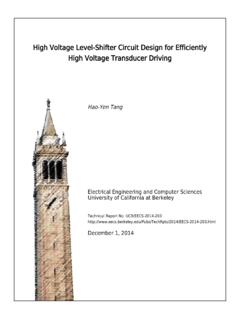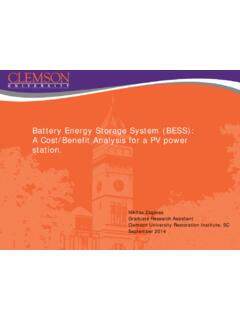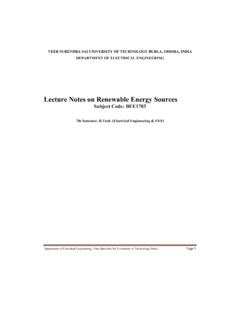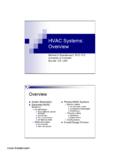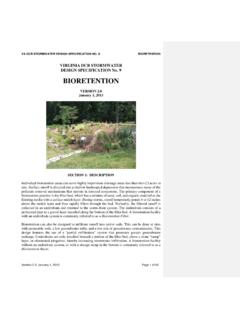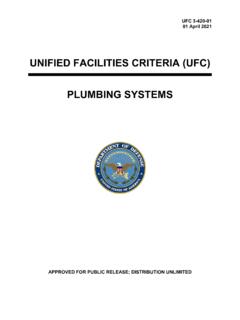Transcription of A Design Methodology for Switched-Capacitor DC-DC …
1 A Design Methodology for Switched-Capacitor DC-DC . Converters Michael Douglas Seeman Electrical Engineering and Computer Sciences University of California at Berkeley Technical Report No. UCB/EECS-2009-78. May 21, 2009. Copyright 2009, by the author(s). All rights reserved. Permission to make digital or hard copies of all or part of this work for personal or classroom use is granted without fee provided that copies are not made or distributed for profit or commercial advantage and that copies bear this notice and the full citation on the first page.
2 To copy otherwise, to republish, to post on servers or to redistribute to lists, requires prior specific permission. Acknowledgement The work in sections and was partially performed while at an internship at Intel during September-December, 2008. The Microglider project was funded by the NSF under Grant No. IIS- 0412541 and by DARPA fund #FA8650-05-C-7138. The PicoCube project was supported by the NSF Infrastructure Grant No. 0403427 and the California Energy Commission Award DR-03-01. I also thank STMicroelectronics for complimentary CMOS fabrication and those at the Berkeley Wireless Research Center.
3 A Design Methodology for Switched-Capacitor DC-DC Converters by Michael Douglas Seeman (Massachusetts Institute of Technology) 2004. (University of California, Berkeley) 2006. A dissertation submitted in partial satisfaction of the requirements for the degree of Doctor of Philosophy in Engineering Electrical Engineeing and Computer Sciences in the GRADUATE DIVISION. of the UNIVERSITY OF CALIFORNIA, BERKELEY. Committee in charge: Professor Seth R. Sanders, Chair Professor Elad Alon Professor Paul Wright Spring 2009. A Design Methodology for Switched-Capacitor DC-DC Converters Copyright c 2009.
4 By Michael Douglas Seeman Abstract A Design Methodology for Switched-Capacitor DC-DC Converters by Michael Douglas Seeman Doctor of Philosophy in Engineering Electrical Engineeing and Computer Sciences University of California, Berkeley Professor Seth R. Sanders, Chair Switched-Capacitor (SC) DC-DC power converters are a subset of DC-DC power con- verters that use a network of switches and capacitors to efficiently convert one voltage to another. Unlike traditional inductor-based DC-DC converters, SC converters do not rely on magnetic energy storage.
5 This fact makes SC converters ideal for integrated implementa- tions, as common integrated inductors are not yet suitable for power electronic applications. While they are only capable of a finite number of conversion ratios, SC converters can sup- port a higher power density compared with traditional converters for a given conversion ratio. Finally, through simple control methods, regulation over many magnitudes of output power is possible while maintaining high efficiency. A complete, detailed Methodology for SC converter analysis, optimization and imple- mentation is derived.
6 These methods specify device choices and sizing for each capacitor and switch in the circuit, along with the relative sizing between switches and capacitors . This method is advantageous over previously-developed analysis methods because of its simplicity and the intuition it lends towards the Design of SC converters. The strengths and weaknesses of numerous topologies are compared amongst themselves and with magnetics- 1. based converters. These methods are incorporated into a MATLAB tool for converter Design . This Design Methodology is applied to three varied applications for SC converters.
7 First, a high-voltage hybrid converter for an autonomous micro air vehicle is described. This converter, weighing less than 150mg, creates a supply of 200V from a single lithium-ion cell ( ) to supply the aircraft's actuators. Second, a power-management integrated circuit (IC) is presented for a wireless sensor node. This IC, with a target quiescent current of 1 A, supplies the system voltages of the PicoCube wireless sensor node. Finally, the initial Design of a high-current-density SC voltage regulator is presented for low-footprint microprocessor applications.
8 Professor Seth R. Sanders Dissertation Committee Chair 2. Contents Contents i List of Figures v List of Tables viii Acknowledgments ix 1 Introduction 1. Switched-Capacitor Converters in Industry and Literature .. 1. Switched-Capacitor Converter Structure and Terminology .. 2. Pre-existing Switched-Capacitor Converter Analysis .. 6. Developments in This Work .. 7. 2 Fundamental Analysis of Switched-Capacitor Converters 10. Slow-Switching Limit Impedance .. 11. Extension to Non-Linear capacitors .. 16. Fast-Switching Limit Impedance .. 18. Calculating Total Output Impedance.
9 21. Model Simplification for Two-Phase Converters .. 24. Modeling Other Converter Loads .. 24. Capacitive Loads .. 25. Current-Source Load .. 26. Inductive Load .. 26. i 3 Optimization of Switched-Capacitor Converters 31. Device Cost Metrics .. 32. Component sizing .. 33. Capacitor sizing .. 35. Switch sizing .. 37. Optimizing Using Other Metrics .. 38. System-Level Converter Optimization .. 41. Converter Loss Components .. 41. Numerical Optimization .. 43. 4 Comparing Switched-Capacitor Topologies 48. Converter Performance Metrics .. 49. Analysis of SC Topologies.
10 50. Ladder Topology .. 51. Dickson Charge Pump .. 55. Fibonacci Topology .. 56. Series-Parallel Topology .. 58. Doubler Topology .. 60. Comparison of SC Topologies .. 61. Symmetrical Topologies .. 64. Comparison with Magnetics-Based Converters .. 66. Switch Comparison .. 67. Reactive Element Comparison .. 71. Fundamental Performance Limits .. 75. SSL Converter Metric Limit .. 76. FSL Converter Metric Limit .. 78. 5 Regulation of Switched-Capacitor Converters 81. Output Ripple of Multiphase Converters .. 83. Hysteretic Feedback Methods .. 88. System Modeling.


